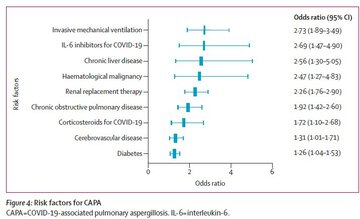Gioia F, Walti LN, Orchanian-Cheff A, Husain S. Risk factors for COVID-19-associated pulmonary aspergillosis: a systematic review and meta-analysis
Lancet Respir Med. 2024
"Identifying key CAPA risk factors in severe COVID-19 patients can help reduce mortality in these high-risk cases".- Dr. Francesca Gioia -
Summary:
Background: COVID-19-associated pulmonary aspergillosis (CAPA) has been reported to be an emerging and potentially fatal complication of severe COVID-19. However, risk factors for CAPA have not been systematically addressed to date.
Methods: In this systematic review and meta-analysis to identify factors associated with CAPA, we comprehensively searched five medical databases: Ovid MEDLINE; Ovid Embase; the Cochrane Database of Systematic Reviews; the Cochrane Central Register of Controlled Trials; and the WHO COVID-19 Database. All case-control and cohort studies in adults (aged >18 years) that described at least six cases of CAPA and evaluated any risk factors for CAPA, published from Dec 1, 2019, to July 27, 2023, were screened and assessed for inclusion. Only studies with a control population of COVID-19-positive individuals without aspergillosis were included. Two reviewers independently screened search results and extracted outcome data as summary estimates from eligible studies. The primary outcome was to identify the factors associated with CAPA. Meta-analysis was done with random-effects models, with use of the Mantel-Haenszel method to assess dichotomous outcomes as potential risk factors, or the inverse variance method to assess continuous variables for potential association with CAPA. Publication bias was assessed with funnel plots for factors associated with CAPA. The study is registered with PROSPERO, CRD42022334405.
Findings: Of 3561 records identified, 27 articles were included in the meta-analysis. 6848 patients with COVID-19 were included, of whom 1324 (19·3%) were diagnosed with CAPA. Diagnosis rates of CAPA ranged from 2·5% (14 of 566 patients) to 47·2% (58 of 123). We identified eight risk factors for CAPA. These factors included pre-existing comorbidities of chronic liver disease (odds ratio [OR] 2·70 [95% CI 1·21-6·04], p=0·02; I2=53%), haematological malignancies (OR 2·47 [1·27-4·83], p=0·008; I2=50%), chronic obstructive pulmonary disease (OR 2·00 [1·42-2·83], p<0·0001; I2=26%), and cerebrovascular disease (OR 1·31 [1·01-1·71], p=0·05; I2=46%). Use of invasive mechanical ventilation (OR 2·83; 95% CI 1·88-4·24; p<0·0001; I2=69%), use of renal replacement therapy (OR 2·26 [1·76-2·90], p<0·0001; I2=14%), treatment of COVID-19 with interleukin-6 inhibitors (OR 2·88 [1·52-5·43], p=0·001; I2=89%), and treatment of COVID-19 with corticosteroids (OR 1·88 [1·28-2·77], p=0·001; I2=66%) were also associated with CAPA. Patients with CAPA were typically older than those without CAPA (mean age 66·6 years [SD 3·6] vs 63·5 years [5·3]; mean difference 2·90 [1·48-4·33], p<0·0001; I2=86%). The duration of mechanical ventilation in patients with CAPA was longer than in those without CAPA (n=7 studies; mean duration 19·3 days [8·9] vs 13·5 days [6·8]; mean difference 5·53 days [1·30-9·77], p=0·01; I2=88%). In post-hoc analysis, patients with CAPA had higher all-cause mortality than those without CAPA (n=20 studies; OR 2·65 [2·04-3·45], p<0·0001; I2=51%).
Interpretation: The identified risk factors for CAPA could eventually be addressed with targeted antifungal prophylaxis in patients with severe COVID-19.
Why do you highlight this publication?
This study stands out as the first large-scale meta-analysis on risk factors for COVID-19-associated pulmonary aspergillosis (CAPA), analyzing data from 8,009 COVID-19 patients across 28 studies. It provides an in-depth analysis of risk factors for COVID-19-associated pulmonary aspergillosis (CAPA), a serious and often fatal complication in critically ill COVID-19 patients. The study identifies specific risk factors-including chronic illnesses, certain COVID-19 treatments, and ICU interventions-that could guide targeted screening and preventive antifungal treatments. This is particularly relevant for reducing mortality in high-risk COVID-19 populations, informing clinical protocols, and potentially preventing CAPA-associated complications and outcomes.
Publication commented by:
Dr. Francesca Gioia
Infectious Diseases Department. INFECTIOUS DISEASES-IRYCIS



